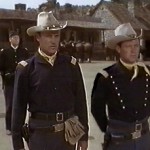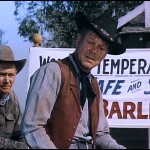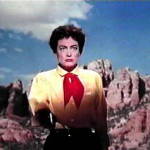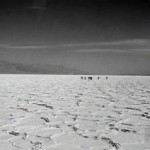



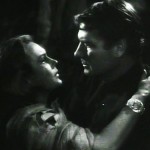

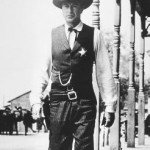

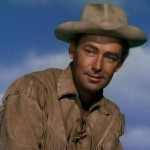
Frank Gruber, who wrote several screenplays, once claimed that there are seven (!) essential Western plots.
1. The Union Pacific story (railroad/stagecoach comes to town, wagon train adventures)
2. The ranch story (ranch conflicts, ranchers vs. others)
3. The empire story (an epic version of the ranch story)
4. The revenge story
5. The cavalry and Indians story
6. The outlaw story
7. The marshal story
Although it is perhaps not possible to fit every Western ever made into one of these categories (some revisionist films spring to mind), Shane undoubtedly fits as a classic conflict between the ruthless big rancher and the honest farmers. In addition it also touches into a category not directly mentioned above, maybe because it isn’t large enough in numbers, the Man with a past type of Westerns. Anthony Mann, in his collaborations with James Stewart specialized in these kind of films, so did Budd Boetticher who picked up most of his stories from writer Burt Kennedy.
Shane (we never get to know the rest of his name) arrives one day at the small homestead of farmer Joe Starrett (Van Heflin), wife Marian (Jean Arthur) and son Joey (Brandon De Wilde). He is offered food and a place to stay for the night, and ends up staying on lending Starrett a helping hand doing farm work. Not after very long he finds himself deeply involved in the farmers’ struggle to remain at their farms despite being harassed by rancher Ryker and his henchmen. After a giant barroom brawl (a classic scene), Ryker decides that enough is enough and sends for a hired hand, a scary man named Wilson (Jack Palance). «He wears a black hat» is the description given of him by one of the farmers. Wilson kills one of the homesteaders in an uneven fight after provoking him to go for his gun, and Shane sees no other option than to strap on his gun and go into town for the last time.
Haters of Westerns probably hates this film, and, in a way it’s understandable. Joey is without doubt annoying to many viewers today. Alan Ladd as Shane is to many an unlikely choice for the hero, dressed as he is in fringed deerskin clothes (did anyone really walk around like that back then?), and the stereotypes are strong and used to full extent. But it really is the definition of the archetypal Western hero presented here by Stevens. Shane is the ideal self-imaged American, the way they wanted to be depicted. He is kind, peaceful, slow to anger, but when forced to do so he executes his moral rights with fierce conviction. Experts on Western folklore has placed Shane to be of European aristocracy, therefore explaining the story’s parallels to the legendary tales of Robin Hood or Sir Lancelot.
That is perhaps stretching it a bit too far, and there really is no need to appreciate the underlying myths to be able to enjoy this film. It is not at all perfect, but still hugely influential, and has a lot to offer also on repeated viewings. For instance, it was just now that I noticed that the town dog leaves the room each time Wilson enters. Which is brilliant.
